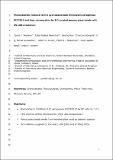Photocatalytic removal of the cyanobacterium Microcystis aeruginosa PCC7813 and four microcystins by TiO2 coated porous glass beads with UV-LED irradiation
Abstract
Cyanobacteria and their toxic secondary metabolites are a challenge in water treatment due to increased biomass and dissolved metabolites in the raw water. Retrofitting existing water treatment infrastructure is prohibitively expensive or unfeasible, hence ‘in-reservoir’ treatment options are being explored. In the current study, a treatment system was able to photocatalytically inhibit the growth of Microcystis aeruginosa and remove released microcystins by photocatalysis using titanium dioxide coated, porous foamed glass beads and UV-LEDs (365 nm). A 35% reduction of M. aeruginosa PCC7813 cell density compared to control samples was achieved in seven days. As a function of cell removal, intracellular microcystins (microcystin-LR, -LY, -LW, and -LF) were removed by 49% from 0.69 to 0.35 μg mL−1 in seven days. Microcystins that leaked into the surrounding water from compromised cells were completely removed by photocatalysis. The findings of the current study demonstrate the feasibility of an in-reservoir treatment unit applying low cost UV-LEDs and porous foamed beads made from recycled glass coated with titanium dioxide as a means to control cyanobacteria and their toxins before they can reach the water treatment plant.
Citation
Pestana , C J , Portela Noronha , J , Hui , J , Edwards , C , Gunaratne , H Q N , Irvine , J T S , Robertson , P K J , Capelo-Neto , J & Lawton , L A 2020 , ' Photocatalytic removal of the cyanobacterium Microcystis aeruginosa PCC7813 and four microcystins by TiO 2 coated porous glass beads with UV-LED irradiation ' , Science of the Total Environment , vol. 745 , 141154 . https://doi.org/10.1016/j.scitotenv.2020.141154
Publication
Science of the Total Environment
Status
Peer reviewed
ISSN
0048-9697Type
Journal article
Description
The authors acknowledge the Engineering and Physical Sciences Research Council (EPSRC) for funding this research [EP/P029280/1].Collections
Items in the St Andrews Research Repository are protected by copyright, with all rights reserved, unless otherwise indicated.

